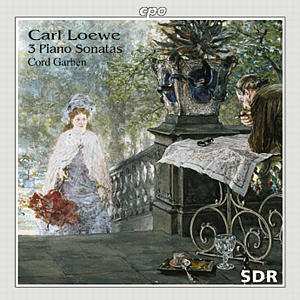|
<< -- 5 -- Roderic Dunnett THE NORTHERN SCHUBERT

'In one of the best-known ballads, Sir Oluf, he uses a wide range
of textures in the accompaniment, yet also contrives to evoke the various
characters -- narrator, child, ghost -- brilliantly. Scapine (der
verliebte Schäferin Scapine, see page 4 above) is even more astonishing
: it starts off larghetto, grows to an allegro, builds to an almost manic
presto, then subsides with a soave diminuendo. At times his ornaments,
turns and little vocal cadenzas, coupled with the sheer dramatic power of
his word-setting, make certain songs feel almost like opera'. (Loewe composed
five or six operas, though witnessed few stagings in his lifetime; aptly
for a ballad-composer, two of them (Malek-Adel and Emmy, were
to libretti after Sir Walter Scott, based on Scott's novels The Talisman
and Kenilworth).
Loewe's other works are just beginning to emerge from the woodwork. Their
quality is by no means to be dismissed. His piano sonatas (recorded convincingly
by Cord Garben on CPO 999 355 2) demonstrate that even in his twenties (and
certainly by the magnificent Grand Sonata in E flat, Op 16, composed in
1829, only just after Beethoven's and Schubert's deaths, he had a command
of the grand manner which characterises, in particular, Weber's sonatas
-- quite apart from an ability to import fugue into sonata form in a way
familiar throughout the period spanning Beethoven's last sonatas and the
age of Liszt and Reubke.

The A Major Piano Concerto -- a bold, assertive key for an upbeat and
assertive work -- feels staggeringly advanced for a work that was first heard
(with the composer as soloist) in 1831. In manner, style and dimensions,
its massive and massy opening movement seems to prefigure the great First
Concerto of Brahms; after that, the 'Hispanic' grazioso middle movement,
in F major, could not be more unexpected. Loewe's Symphony, in D minor,
includes a thunderous scherzo which any composer would be glad to have written
and a measured finale that bears marked affinities to the serene, chorale-like
manner of Mendelssohn's Reformation Symphony.
Despite the promise of Rudolph, der deutscher Herr, his youthful
grand opera of 1825 which was admired by Spontini but never staged, the
only opera of Loewe's to be properly performed in the theatre was Die
drei Wünsche (Berlin, 1834), which initially enjoyed great popularity.
His most celebrated choral work was Die Siebenschläfer, taking
its place (alongside Spohr and Mendelssohn) among the most highly rated
oratorios of the 19th century, as did (at the outset) The Destruction
of Jerusalem, premièred four years earlier, in 1829. Gutenberg,
based on the great German founder of medieval printing, was a foray into
the form of historical oratorio. Loewe's last oratorio, The Raising of
Lazarus (Capriccio 10 581), manifestly lacks his earlier youthful
fire, partly also because both it and The Healing of the Blind Man were
composed for semi-amateur performance; the former was only orchestrated
(by others) half a century later. But Das Sühnopfer des neuen Bundes
(The Atonement of the New Testament), though recorded in a less
than ideal acoustic on a German label (FCD 97755), has a distinction and
weight to the choral and solo writing that makes it well worth a possible
revival.
Continue >>
Copyright © 7 February 2002
Roderic Dunnett, Coventry, UK
 INTERNATIONAL CARL LOEWE SOCIETY
LISTEN TO LOEWE SONGS AND PIANO SONATAS ON CPO
A LOEWE SYMPHONY & PIANO CONCERTO ON KOCH
AN HISTORIC CARL LOEWE RECORDING
CARL LOEWE AT AMAZON.COM
FISCHER-DIESKAU SINGS LOEWE ON DG
<< Music
& Vision home
Igor Kipnis >>
INTERNATIONAL CARL LOEWE SOCIETY
LISTEN TO LOEWE SONGS AND PIANO SONATAS ON CPO
A LOEWE SYMPHONY & PIANO CONCERTO ON KOCH
AN HISTORIC CARL LOEWE RECORDING
CARL LOEWE AT AMAZON.COM
FISCHER-DIESKAU SINGS LOEWE ON DG
<< Music
& Vision home
Igor Kipnis >>
|

